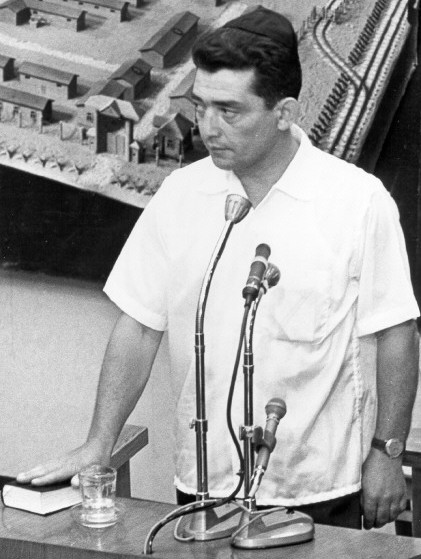[back] Eye Witnesses [back] Diesel gassing

Eliahu Rosenberg
[back] Eye Witnesses
[back]
Diesel gassing
[Witness of Treblinka and Diesel gassing.]
[2007] Provanian Exterminationism, the "Death Camp" Treblinka, and the Demjanjuk Case By Paul Grubach
Eliahu Rosenberg’s 1947 deposition on Treblinka by Thomas Kues
8: Eliyahu Rosenberg: A Treblinka witness at the Eichmann trial in 1961 makes some mistakes on the witness stand. ONE THIRD OF THE HOLOCAUST
Quotes
In 1947, the testimony of Elias Rosenberg was published. He was another
"Holocaust survivor" who saw the "extermination system" at Treblinka with "his
own two eyes." He said the Jews were killed with the exhaust from a Diesel
engine. In his own words: "As it was very dark in the chambers, one could not
see that alongside the walls ran several pipes, about five centimeters in
diameter through which the gas—exhaust gas from a single diesel motor—was piped
into the cabin." Let it suffice to say that he was one of John Demjanjuk’s chief
accusers at the latter’s trial in Israel. Indeed, at Demjanjuk’s show trial it
was again "proven" that a Diesel engine was used at Treblinka to generate the
deadly gas. [2007]
Provanian Exterminationism, the "Death Camp" Treblinka,
and the Demjanjuk Case By Paul Grubach
The deposition made by
Eliyahu Rosenberg in Vienna in 1947 does not only contain statements which defy
common sense, there also several statements which contradicts the orthodox
Treblinka historiography. Most important of them is the dating of the
construction of the second-phase gas chamber building to March 1943, six months
later than the standard narrative has it.
Rosenberg was born in Warsaw on
March 10, 1924. He was thus 18 when deported to Treblinka II, and 23 at the time
he made the deposition. Senility could not have been an issue, and merely four
years had passed between the alleged events and their recounting. It would have
been one thing if Rosenberg wrote that the construction began in August or
November 1943; it is conceivable that he could have been mistaken by a month or
two. Being wrong with a marginal of half a year is another thing entirely.
According to standard historiography, construction on the new gas chamber
building began in late summer/early autumn 1942. Rosenberg on the other hand has
the work begin in March 1943, on the verge of spring. The winter between those
two dates was the only one Rosenberg spent in the camp (in fact, it was the only
winter during which the camp existed). We should thus expect the witness four
years later to be able to tell which major episodes took place prior to the
winter, and which took place afterwards.
Taken together with the statements
regarding the size of the camp, the look of the corpses, and the alleged mass
graves, the above contradiction serves to demonstrate the blatant unreliability
of Eliyahu Rosenberg’s 1947 Vienna deposition. If his later accounts came closer
to the standard version of the camp’s history, it is likely due to Rosenberg
acquainting himself with other witness literature. Eliahu Rosenberg’s 1947 deposition on Treblinka
by Thomas Kues
Rosenberg was the witness who swore that the Ukrainian-born Cleveland mechanic John Demjanjuk was the one and the same as “Ivan the Terrible”, a notorious guard at the Treblinka “death camp” – only for it to be found out that he had previously testified that “Ivan” had been killed during a prisoner uprising. Eliahu Rosenberg’s 1947 deposition on Treblinka by Thomas Kues